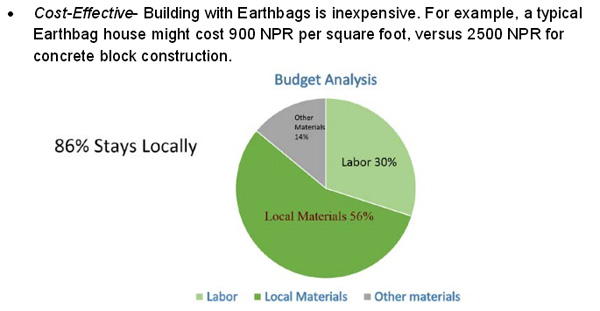
The Nepal Engineer’s Association (NEA) invited me and Kateryna of Good Earth Nepal to submit a technical summary of earthbag building, which has just been published. An excerpt is below. The full report is also now free online at Earthbag Building.com. You might remember that Good Earth Nepal won the NEA people’s choice design award a few months ago. Visit our main website Earthbag Building.com for complete information on earthbag building, including related reports, testing info, workshops and videos.
Earthbag technology is an inexpensive, simple and sustainable method for building structures. Having evolved from military bunker construction and flood control methods, Earthbag buildings are notable for their ability to endure fire, flood, wind, earthquake and vermin, and are used in disaster-prone zones all over the world. In Nepal, 55 Earthbag buildings survived a 7.8 magnitude earthquake with no structural damage. Because Earthbag technology makes minimal use of cement, concrete, steel and timber – and the fuel needed to transport them – the technique is easy on the environment, and doesn’t deplete scarce natural resources. Earthbag technology also requires less expertise than more traditional building methods, and only the simplest of tools.
Though relatively “new”, the basic principles behind Earthbag technology have been around for centuries. Some call Earthbag technology “Rammed Earth in a Bag” or “Reinforced Rammed Earth”.

[Comment has been edited because it sounds trollish. The essence of the comment was something like “Earthbag is low cost, so why did the Good Earth Nepal school cost almost $22,000?]
Here is Kateryna’s reply:
The Kamala house cost about $7000 during monsoon season. We funded it ourselves.
It looks like the person is talking about classrooms- we have an open source design available for download from our website. The internal dimensions are 16*20 and external 52*23.
We spent about $20,000 to built Agra school because of the remoteness of location and we built it during gas crises. We funded Agra completely ourselves. We use cement plaster for internal, external walls and floor. We had to hire porters to carry the materials uphill. It was a difficult site with very poor road access and it took us 3 months excluding festivals.
If people ask us how much it costs to build 2 classrooms, we say anywhere between $15000 – $20 000 depending on location, labor cost and availability of local materials. When we build schools we use galvanized mesh to connect internal and external walls, cement bond beam and cement plastering.
It is school, so we don’t compromise the reinforcements, unlike the houses when we can do mud plastering and timber bond beam.
Good Earth Nepal serves as a technical partner to other NGOs and our standard fees – $25 per day for 1 technical supervisor + 10% admin fees that includes accounting, quality control and progress reports for a duration of the project.
So far we have supervised 3 houses and 1 school sponsored by others. The school in Nuwakot cost estimate is $17,000 for 2 classrooms including our supervision fees and it looks like we are saving now since the prices went down and we are planning even to build a toilet from the money we are saving.
And in fact it is perfectly legal for non profit to charge for services as long as the ‘profit’ does not go to the pockets of the owners, but goes towards the accomplishment of the mission.
It’s been almost a year since me and our co-founders including our Nepali Executive director Roshan are not getting paid at all for our work, we are purely volunteering using our savings for almost a year. so whoever wrote it is absolutely clueless about what we are doing and why.”